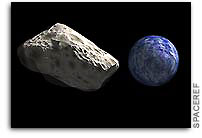Asteroid 2004 VD17 Classed as Torino Scale 2

At the end of February, orbital calculations for near-earth-asteroid (NEA) 2004 VD17 indicated that the risk of an impact within the next century (specifically on May 4, 2102) was higher than that of any other known asteroid. The probability, based on 687 telescopic observations spanning 475 days, is listed on the NASA/JPL NEO Program webpage as a bit less than 1 in 1000. This probability, while small, raises the possible 2102 impact to a Torino scale value of 2 (meriting attention from astronomers), which is higher than any other asteroid. (Note: the impact probability for 1950 DA is larger, but since this hazard is not realized until 2080, it falls outside the one-century range of the Torino scale).
Judging from its brightness, NEA 2004 VD17 has a nominal diameter near 500 m and a mass of nearly a billion tons. While below the threshold for a global catastrophe, the nominal impact energy of more than 10,000 megatons is comparable to all the world’s nuclear arsenals. There are no radar observations available, and the asteroid has not been characterized in any detail, so all these numbers should be taken as approximate.
For comparison, NEA Apophis (formerly 2004 MN4) is currently listed on the NEO webpage as Torino scale 1, with an impact probability on April 13, 2036, of about 1 part in 5000. Apophis is also smaller, with a nominal diameter of 300 m and mass of less than 100 million tons. These are the only two asteroids currently with a Torino Scale listing of greater than 0.
Fortunately, it is nearly a century before the close pass from VD17. This should provide ample time to refine the orbit and, most probably, determine that the asteroid will miss the Earth. On the other hand, there are no near-term opportunities for additional observations, so VD17 will probably remain at Torino scale 2 for quite some time.
All the above information is taken from the NASA/JPL NEO Program Office webpage at http://neo.jpl.nasa.gov.









